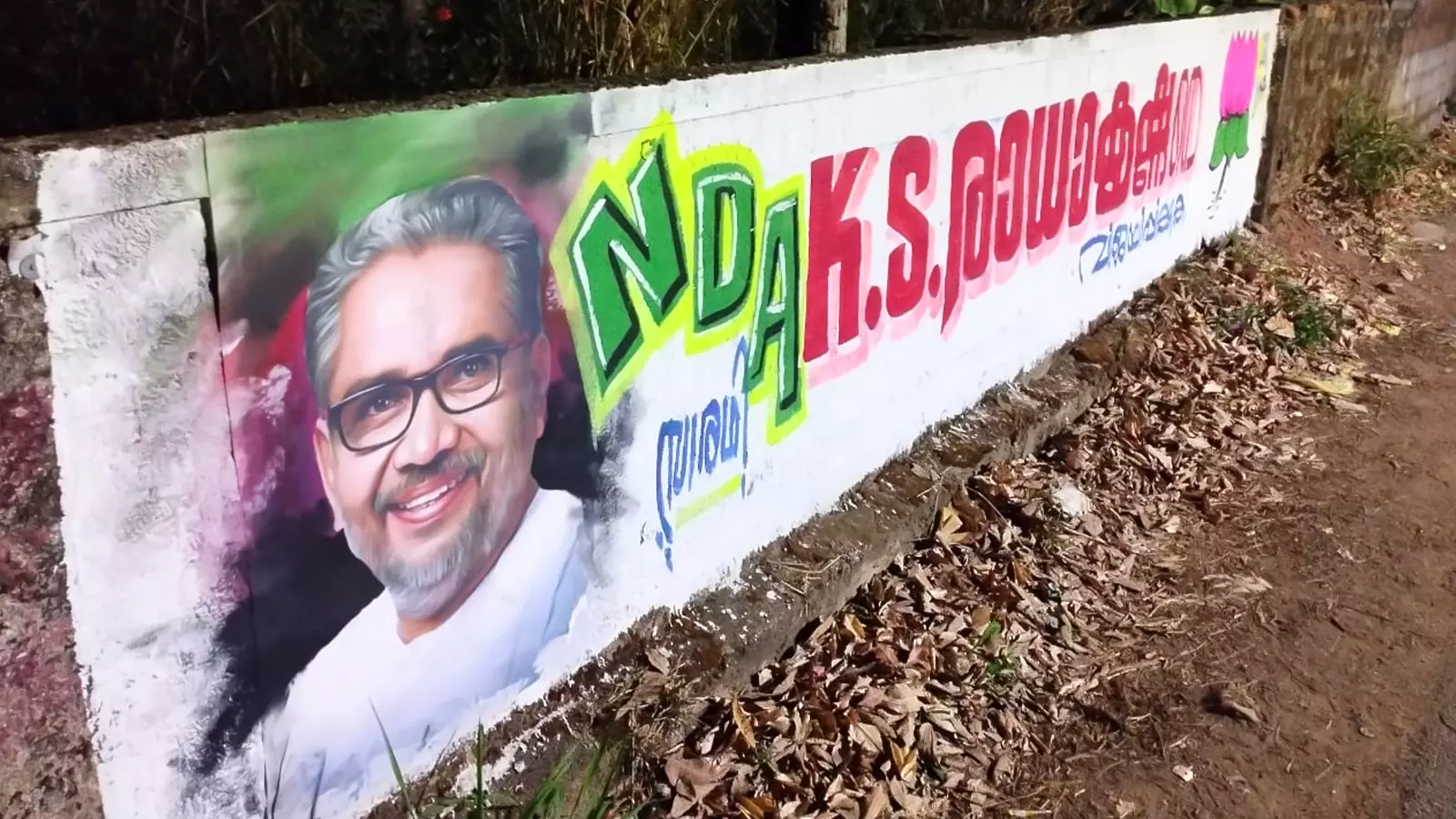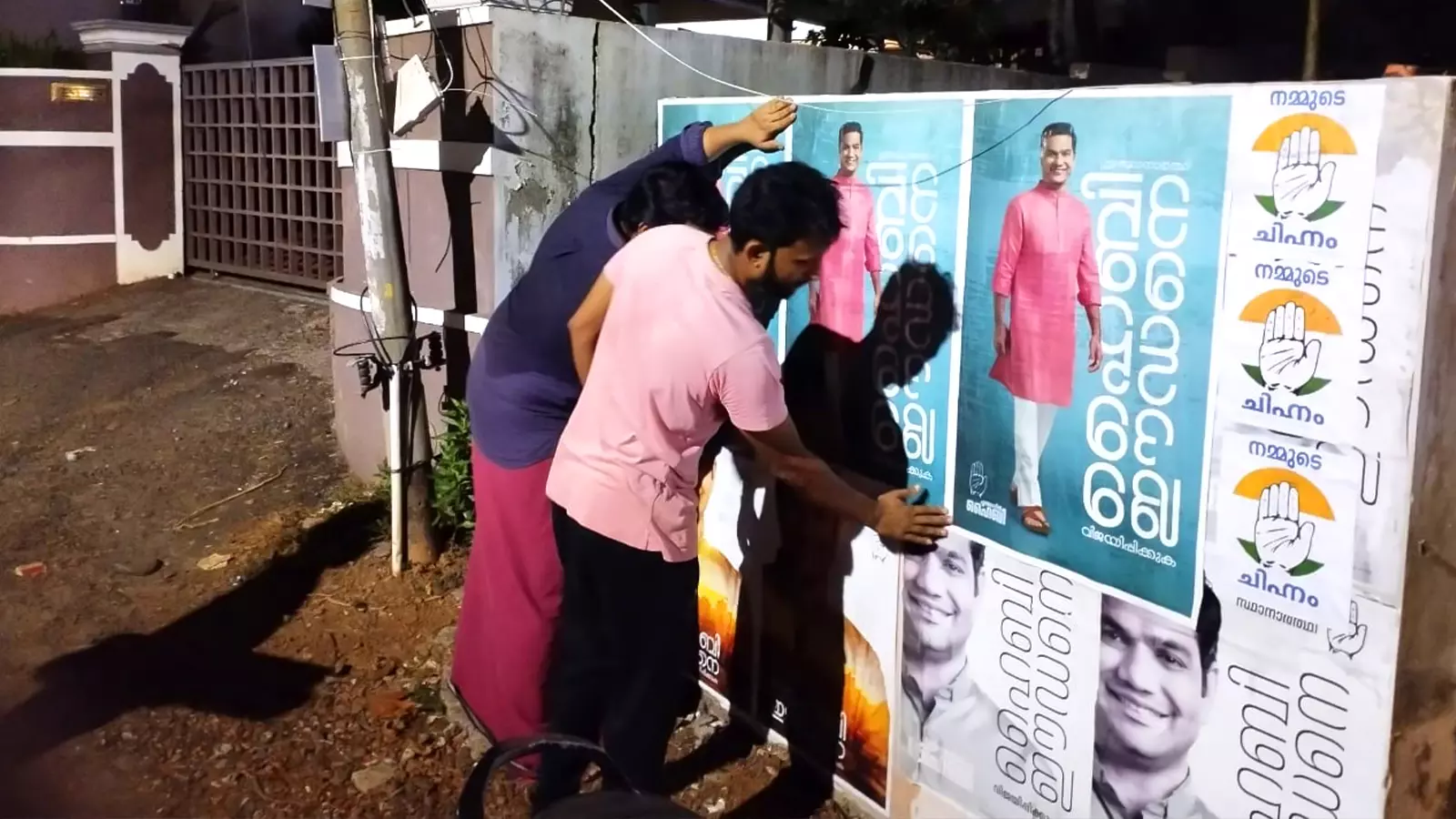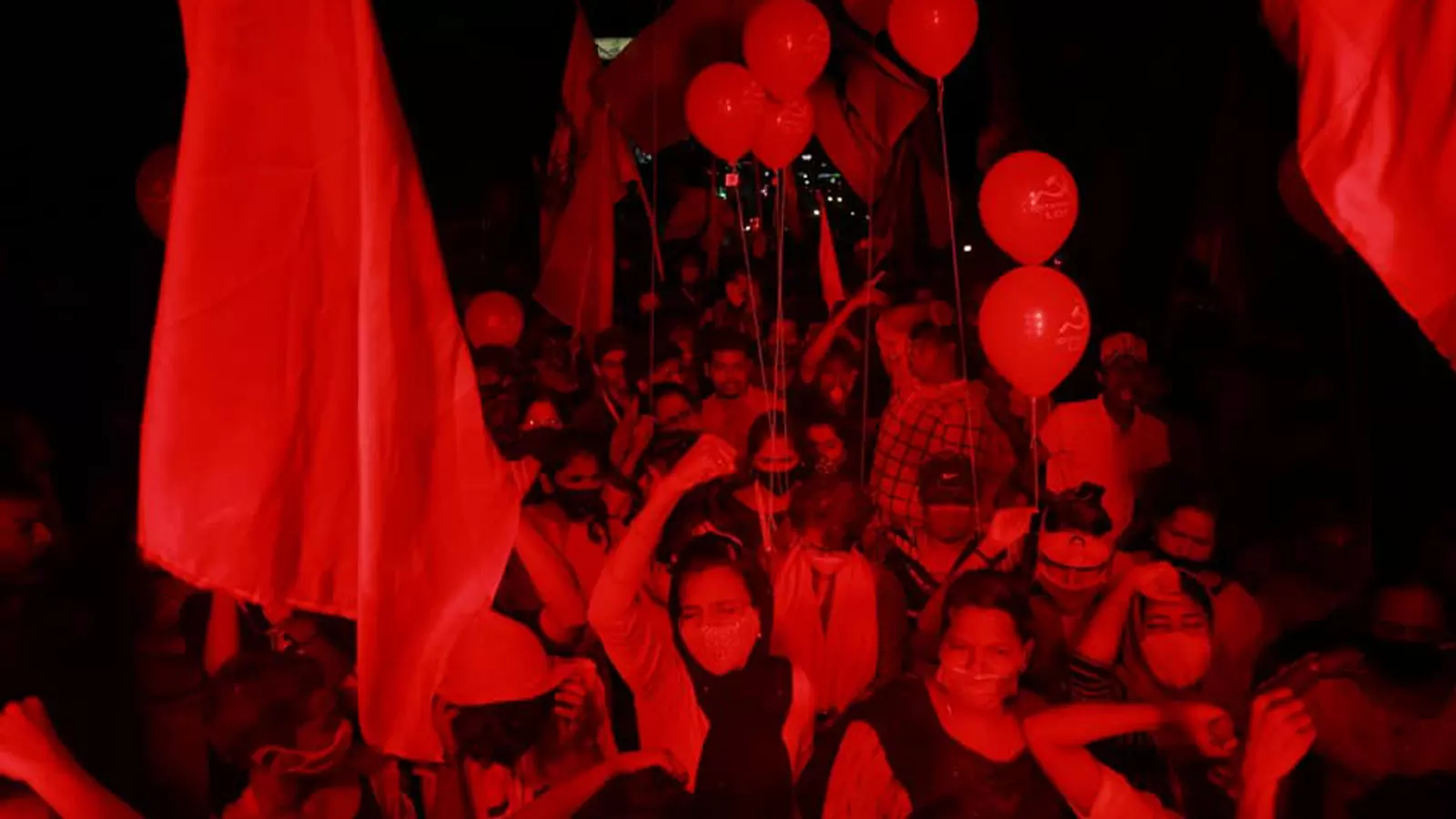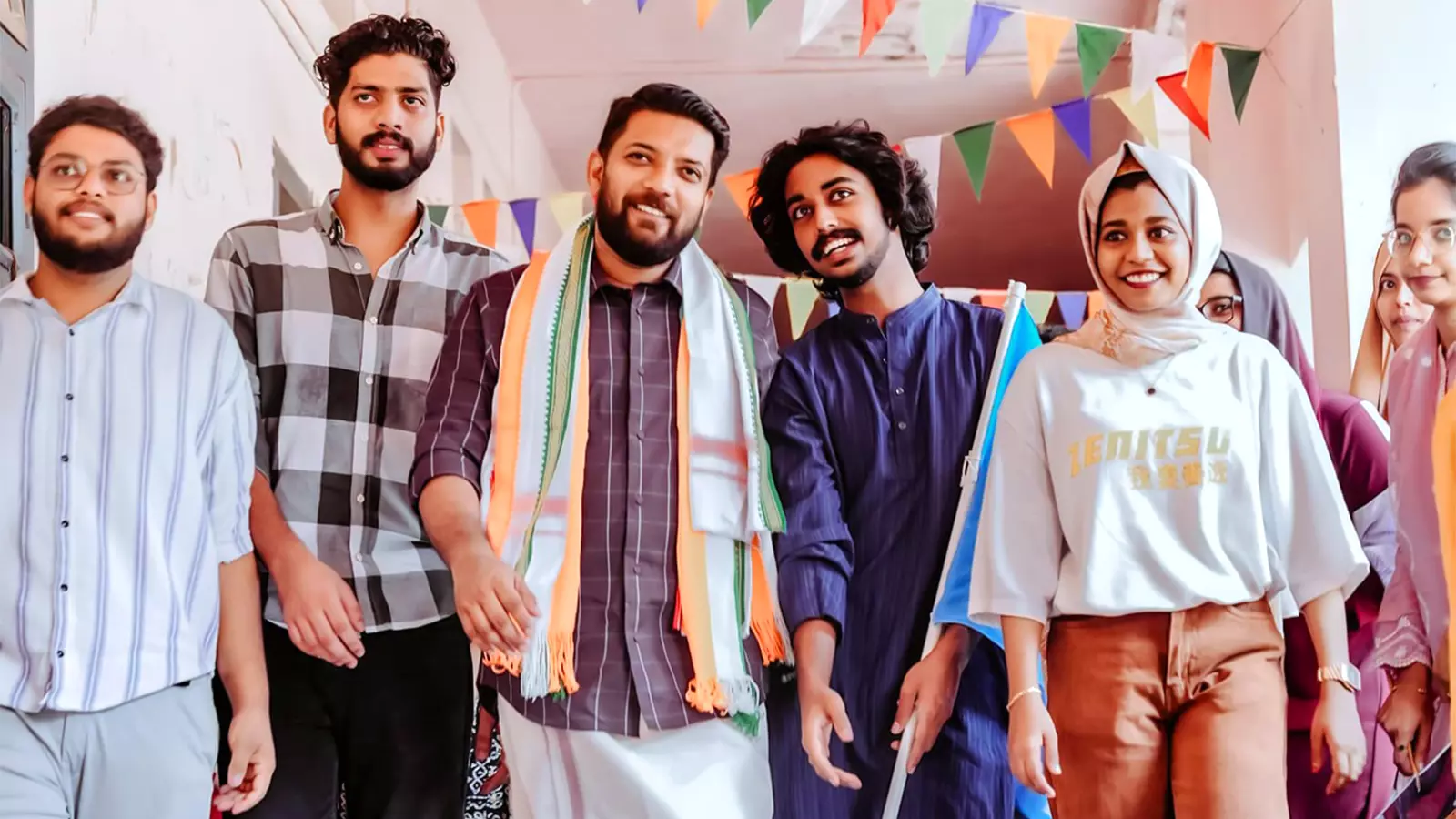
- Home
- India
- World
- Premium
- THE FEDERAL SPECIAL
- Analysis
- States
- Perspective
- Videos
- Sports
- Education
- Entertainment
- Elections
- Features
- Health
- Business
- Series
- In memoriam: Sheikh Mujibur Rahman
- Bishnoi's Men
- NEET TANGLE
- Economy Series
- Earth Day
- Kashmir’s Frozen Turbulence
- India@75
- The legend of Ramjanmabhoomi
- Liberalisation@30
- How to tame a dragon
- Celebrating biodiversity
- Farm Matters
- 50 days of solitude
- Bringing Migrants Home
- Budget 2020
- Jharkhand Votes
- The Federal Investigates
- The Federal Impact
- Vanishing Sand
- Gandhi @ 150
- Andhra Today
- Field report
- Operation Gulmarg
- Pandemic @1 Mn in India
- The Federal Year-End
- The Zero Year
- Science
- Brand studio
- Newsletter
- Elections 2024
- Events
Lok Sabha polls 2024: Who is winning the war of graffiti in Kerala?

“The letters were blue, and the symbols—sickle, hammer, and star—were painted in red on a newly built culvert on the panchayat road somewhere near Pazhanji,” recalled 86-year-old Unni Nair, in a feeble voice but his eyes shining as he reflected on memories of days gone by.“That was my first graffiti work, back in 1971, and the candidate was late communist leader ASN Nambeesan, I...
“The letters were blue, and the symbols—sickle, hammer, and star—were painted in red on a newly built culvert on the panchayat road somewhere near Pazhanji,” recalled 86-year-old Unni Nair, in a feeble voice but his eyes shining as he reflected on memories of days gone by.
“That was my first graffiti work, back in 1971, and the candidate was late communist leader ASN Nambeesan, I guess. I had just returned home from Calcutta (now Kolkata) after completing my military service. I used to draw and paint a bit, and my handwriting was very good. I used lime water to whitewash the wall and washing blue, brick powder to draw. It was the first time I experimented with the modern calligraphy I had seen on the walls of Kolkata, and soon, I was taken to many places to draw hammer, sickle, and star symbols,” he said.
As Unni spoke, his voice softened, reminiscing about his continued involvement in graffiti during subsequent elections, shaping the political landscape with his art. “I continued to do poll graffiti in the next couple of elections too, before the youngsters took over.”

BJP candidate KS Radhakrishnan's graffiti with his stencilled mugshot.
Unni Nair, who lives with his grandchildren in Ernakulam these days, is one of those old generation of local political workers who painted the picture of the Left movement in rural Kerala.
In the vibrant landscape of Kerala’s political consciousness, amidst the cacophony of social media this age-old tradition still thrives: the art of graffiti and hoardings adorning public spaces. While the digital age surges forward, there's a certain timeless appeal to the hand-painted slogans and election symbols that grace the walls, capturing the attention of voters and parties alike.
From its ancient origins in the streets of ancient Greece and Rome to its modern-day manifestations across continents, graffiti has remained a powerful tool for expression and activism. In France, it's been a voice against or in support of various social and political movements, while in Latin America, it's served as a battleground against imperialism.
Throughout history, graffiti has held a special place in the narrative of revolts against injustice, serving as a unique form of protest art. Take, for instance, the slogan of the French revolution: ‘Liberty, equality, and fraternity’, which became emblematic of the period. Similarly, the Bolsheviks’ slogan during the October revolution, ‘All power to the soviets,’ and ‘Hasta La Victoria Siembre’, from Che Guerra’s farewell letter to Castro, not only adorned walls but also reverberated as a rallying cry for change.
In India, the evolution of political graffiti closely mirrors the trajectory of the Leftist political movement.
“During the heyday of the Naxalite movement, Kerala’s walls became a canvas for opposing the prevailing hegemonic slogans and symbols. Naxalite slogans such as ‘Long live Naxalbari’ and ‘Political power comes out of the barrel of the gun’ emerged prominently, adorning walls across the state during the peak of Naxalism's influence in Kerala,” opines KP Sethunath, senior journalist who has done an extensive deep dive into the subject.

Congress workers sticking posters of Hibi Eden designed by Zainul Abid.
“The presence of political graffiti in regions like West Bengal, Kerala, Andhra Pradesh (Telangana included), Chhattisgarh, and certain parts of Odisha is intriguing, and it may be closely tied to the strong working-class movements prevalent in these areas,” adds Sethunath.
With the evolution of electronic media over time, political graffiti gradually made room for commercial wall art and announcements related to elections or programmes, especially in Kerala and predominantly became an election time affair.
In a country like India where democratic election pulses through every vein of society, poll graffiti isn't just an art form—it's a livelihood for many, a means of livelihood for some, and a cornerstone of political campaigning. Yet, as modern printing technology encroaches and flex boards replace painted walls, the landscape is shifting. The ease and efficiency of flex boards threaten to eclipse the painstaking artistry of graffiti, raising questions about the future of this age-old tradition in the digital age.
“I’ve always had a passion for drawing and have been involved in Leftist politics, so it felt natural for me to engage in graffiti. I've been doing this for over 20 years, and election seasons are particularly exciting,” says Babu Padiyath a local artist in Ponnani, Malappuram district.
“However, in the past decade or so, digital printing and flex hoardings have dominated the scene. Nowadays, I find myself alone in this pursuit; I used to have many helpers, but I can no longer afford assistants. Nonetheless, this remains my passion,” Babu told The Federal.
Zainul Abid, the internationally acclaimed designer, based in Kochi observes that politicians and their communication strategies are adapting to contemporary life, albeit not as rapidly as industries like film or fashion. He finds himself extremely occupied during election seasons, as numerous Kerala politicians seek his expertise for state-of-the-art campaign materials.
“We have got different kinds of clients. There are the ones who just let us do our thing, give us total freedom with the design. Take Hibi Eden, for example, the United Democratic Front candidate in Ernakulam—he's all about that. We handled his posters and designs last time around, and they were a hit. So much so that loads of other candidates in the local and assembly elections ended up copying them. It was way different from the usual political stuff. Like, we played around with cropped faces, half-exposed imagery, and some funky lettering—stuff you don't normally see from politicians,” says Abid.
“These days, it’s the agencies handling this stuff, not the politicians themselves. Actually, most candidates don’t even have much say in their campaign materials anymore. Like, we did Rahul Gandhi's posters, but there were so many people calling the shots—it felt like organising an orphan's wedding, everyone trying to play parent,” Abid said.
Communist candidates, who previously shied away from heavy spending on campaign materials, as they had a lot of volunteers who could do it, are now more open to investing in them. Abid counts many Left-leaning candidates among his clients.
“The Left candidates and leaders, especially the CPI(M) guys, are sharp on slogans, and even the tiniest of details, they know what they want and we are just left with the job of making it trendy. As for the latest trends, forget about the traditional party colours. Red isn’t the go-to for CPI(M) candidates, and Congress folks aren't keen on the tricolour either. Many of them, especially the Congress bunch, insist on having their mug shots printed big. It's all about breaking away from the cliché photo shoots—none of those folded hands stuff,” Abid told The Federal.
In today's campaigns, parties not only rely on contemporary visual art designs such as posters and hoardings but also extensively utilise audiovisual mediums beyond social media. Short films, music albums, songs, and various visual arts have become integral components of election campaigns. DJ gatherings in public spaces, replacing traditional rallies and corner meetings, particularly in the evenings, have become a common sight in Kerala.

DJ gatherings in public spaces are gradullay replacing traditional rallies and corner meetings in Kerala.
“We've been receiving DJ orders from political parties. Today, I've been booked by CPI(M) workers in the Alathur constituency for their candidate K Radhakrishnan's campaign, and we're gearing up for it,” said Satheeshan, who operates a light and sound business in Thrissur. “They'll send us a vehicle, and we'll need to set up the audio system with bass boosters and all, and assign a DJ for the event. The party members will select the songs, and we have no role in that,” added Satheesan.
Numerous songs, ranging from parodies of popular film tracks using karaoke to originally composed pieces, have been created and recorded for public campaigns. Each election cycle witnesses the emergence of hit songs, establishing this as a new trend in the state.
“Previously, parties primarily relied on karaoke and parody songs, but lately, they have begun creating original songs, granting them freedom in content. Many of these songs boast high quality, featuring film lyricists, composers, and singers,” Biju Unity, who runs a recording studio in Kozhikode tells The Federal. “Both the BJP and the LDF are meticulous about the content, whereas Congress workers do not seem to be keen about it,” observes Biju.
Despite the abundance of audiovisual campaign materials flooding social media platforms with contemporary content, there remains a significant audience for traditional forms such as street plays, live performances, and neighbourhood meetings. A 20 to 25-minute live performance, featuring a short street play conveying a powerful message, a couple of songs, some skits, and an introductory and concluding speech, constitutes a comprehensive campaign package, particularly effective in rural areas.

“Neighbourhood meetings are the most effective campaign method," asserts Joshi Edassery, a CPI activist in Thrissur. Currently on vacation in his hometown, Joshi, an NRI, leads a group that performs street plays and songs for VS Sunil Kumar’s campaign. If you can organise 10-15 such meetings in a booth, it would be more effective than any other strategy. There's still an audience for small performances, and they resonate well with the masses in this era of communication overflow. Posters and wall graffiti also carry this impact. When we travel through an area saturated with certain candidates' graffiti all around, he or she automatically gains an advantage in the campaign,” observes Joshi.
In Kerala's context, BJP campaign managers are placing a greater emphasis on resonating devotional content, particularly targeting the Hindu demographic. Their campaign materials predominantly feature value and morality-based items aligned with these themes. Temples and characters from the epics serve as strong focal points for their campaign strategy, drawing parallels between these revered images and their candidates, which is their forte.

Shafi Parambil during a campus campaign.
“It’s not entirely true that the Left has a monopoly over campaigning through art and aesthetics,” says Faizal Babu, who is campaigning for the UDF candidate Shafi Parambil in Vadakara. “We are also using all these art forms, and our shows are attracting huge crowds everywhere,” he adds. Shafi Parambil is one candidate from the UDF fold who is paying keen attention to adopting these strategies, and the youth Congress team he has with him makes it very effective as well.
On the other side, campaigners for VS Suni Kumar of the CPI have gone the extra mile by publishing a book, reminiscent of campus election nostalgia and his political journey narrated by 50-odd people from different walks of life.
From traditional graffiti to captivating DJ performances on the streets, the election campaign in Kerala showcases its distinctiveness not only in content but also in its presentation.
